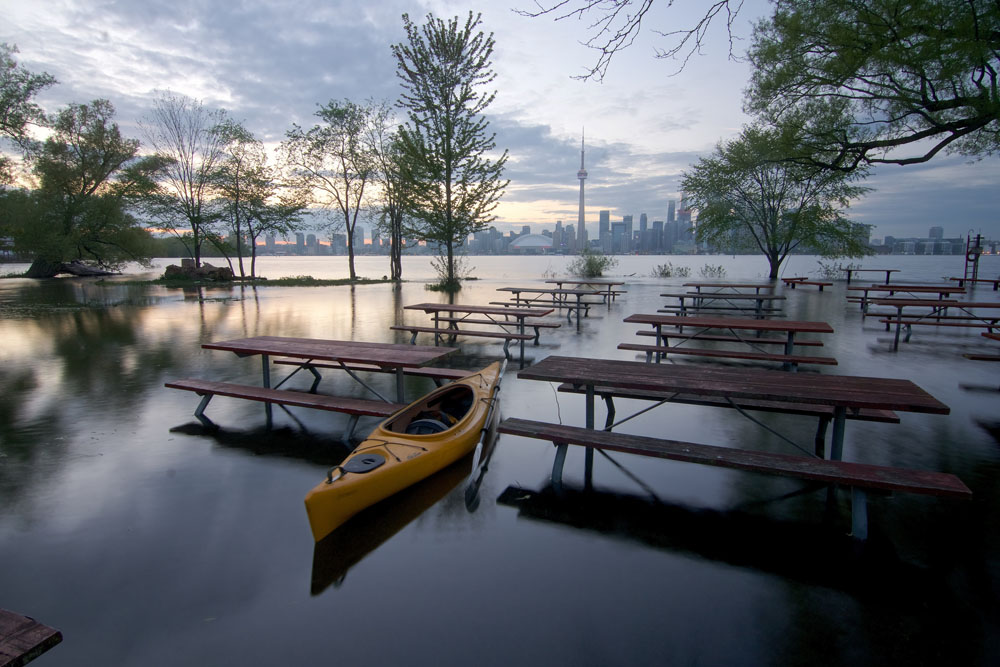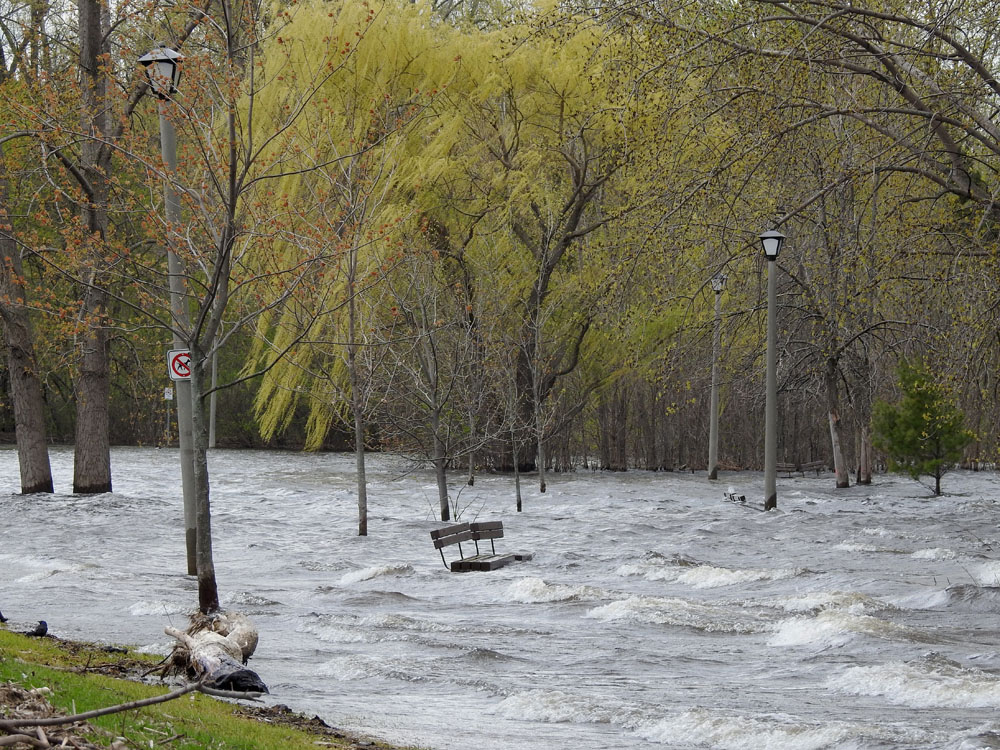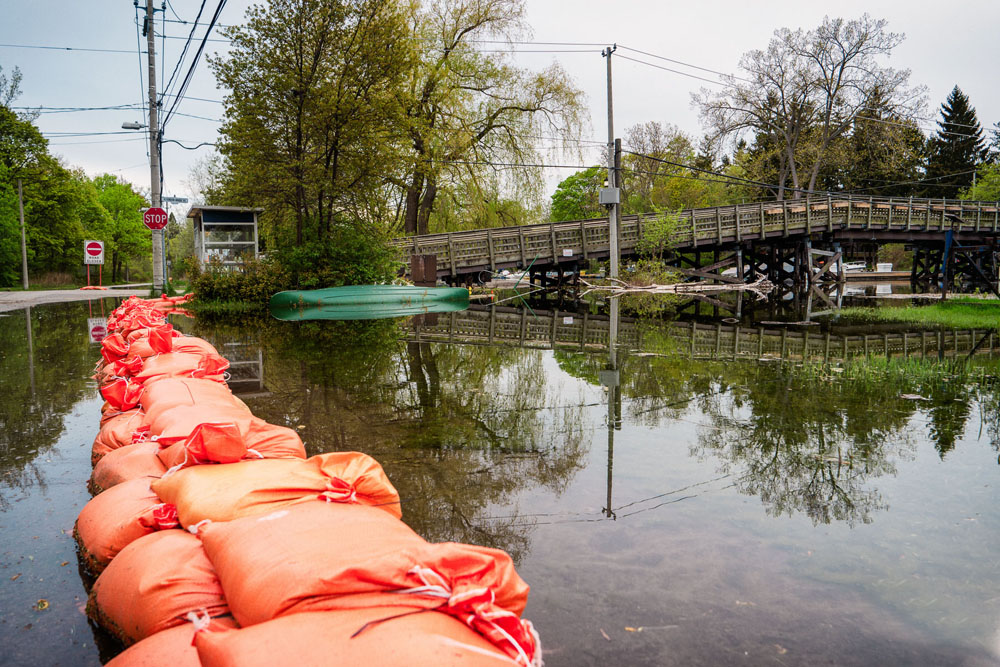Round Table: Resilient renewal
How to design for climate events
MODERATED BY KANWAL AFTAB AND KATIE STRANG
BIOS/
CYNTHIA GRAHAM, OALA, WORKS WITH THE CITY OF HAMILTON’S LANDSCAPE ARCHITECTURAL SERVICES SECTION, WHICH PROVIDES PARK, TRAIL AND OPEN SPACE DEVELOPMENT DESIGN AND CONSTRUCTION SERVICES. CYNTHIA IS THE MANAGER WHO OVERSEES THE SECTION TO ENSURE DELIVERY OF CAPITAL PROGRAM, QUALITY CONTROL AND REPORTING, PREPARATION OF CAPITAL AND OPERATING BUDGETS, CONSULTATION WITH COUNCIL, AND LIAISON WITH STAKEHOLDERS.
DEBORAH KENLEY, SENIOR COORDINATOR, GREENING CORPORATE GROUNDS (GCG) HELPS CORPORATIONS AND INSTITUTIONS IN THE CREDIT RIVER WATERSHED INVEST IN NATURE AND BECOME LEADERS IN SUSTAINABILITY BY ADOPTING ECOLOGICAL LANDSCAPING AND STORMWATER MANAGEMENT BEST PRACTICES. DEBORAH WORKS WITH MEMBERS TO IDENTIFY OPPORTUNITIES THAT REDUCE THE IMPACTS FROM CLIMATE CHANGE, CREATES HABITAT FOR WILDLIFE, AND MAXIMIZES AESTHETIC APPEAL AND ECOLOGICAL BENEFITS ON THEIR PROPERTY.
MICHELLE MOLNAR IS THE TECHNICAL DIRECTOR OF THE MUNICIPAL NATURAL ASSETS INITIATIVE, AS WELL AS AN ENVIRONMENTAL ECONOMIST AND POLICY ANALYST AT THE DAVID SUZUKI FOUNDATION. HER WORK FOCUSES ON THE CONSERVATION OF NATURAL CAPITAL USING VARIOUS TOOLS OF ECOLOGICAL ECONOMICS, POLICY ANALYSIS, AND PUBLIC OUTREACH. SHE IS THE AUTHOR OF SEVERAL NATURAL CAPITAL VALUATIONS AND SITS ON THE B.C. GOVERNMENT’S CLIMATE SOLUTIONS AND CLEAN GROWTH ADVISORY COUNCIL.
OLIVIA SPARROW IS ORIGINALLY FROM SOUTHERN ONTARIO, AND HAS SUPPORTED CLIENTS ACROSS CANADA AND THE MID-WESTERN UNITED STATES FOR SEVEN YEARS THROUGH WATER RESOURCES MODELLING, STORMWATER BMP DESIGN, STORMWATER MANAGEMENT PLANNING, AND BMP MONITORING PROJECTS. OLIVIA WAS A KEY CONTRIBUTOR IN SEVERAL RECENT PROJECTS, INCLUDING THE CITY OF THUNDER BAY’S STORMWATER MANAGEMENT PLAN, THE RURAL STORMWATER MANAGEMENT MODEL FOR THE EASTERN SHORE OF LAKE HURON, AND DEVELOPING A PRIORITIZED INVENTORY OF OVER 85,000 URBAN LOW IMPACT DEVELOPMENT RETROFIT OPPORTUNITIES IN EDMONTON. OLIVIA’S WORK CONTINUES TO ESTABLISH PLANS, POLICIES, REGULATORY FRAMEWORKS, AND BEST MANAGEMENT PRACTICES AIMED AT MITIGATING THE DETRIMENTAL IMPACTS OF LAND DEVELOPMENT ON WATER RESOURCES, ECOSYSTEMS AND COMMUNITIES.
MIKE WILLIAMS IS A LONG TIME EMPLOYEE WITH DUCKS UNLIMITED CANADA (DUC). HE BEGAN HIS CAREER IN NORTHERN ALBERTA IN 1990 AS THE AREA BIOLOGIST FOR THE GRANDE PRAIRIE OFFICE AND REMAINED THERE UNTIL 1997. SINCE RELOCATING TO SOUTHERN ONTARIO, MIKE HAS WORKED IN VARIOUS ROLES DESIGNING AND IMPLEMENTING WETLAND HABITAT PROGRAMS AT THE LANDSCAPE LEVEL. IN 2016, MIKE TOOK ON THE ROLE OF HEAD OF RESTORATION AND CLIENT SERVICES AND MANAGES THE OUTSOURCING DUC HABITAT RESTORATION SERVICES TO INDUSTRY, DEVELOPERS AND OTHER CONSERVATION AGENCIES.
KANWAL AFTAB IS A DESIGNER AND WRITER BASED IN TORONTO. WITH DEGREES IN ARCHITECTURE, LANDSCAPE, ART HISTORY AND ECONOMICS, SHE CURRENTLY WORKS AS AN URBAN DESIGNER FOR THE CITY OF BRAMPTON, TEACHES AT THE DANIELS FACULTY OF ARCHITECTURE, LANDSCAPE AND DESIGN AND IS A MEMBER OF THE GROUND EDITORIAL BOARD.
KATIE STRANG IS A GROUND EDITORIAL BOARD MEMBER AND WORKS AT THE PLANNING PARTNERSHIP.

Kanwal Aftab: What do you see, through the work of your organization, as the biggest climate change issue facing Canada and Ontario? How have the efforts within your particular organizations focused on mitigating that issue?
Deborah Kenley: There are two issues we struggle with. Stormwater management is definitely a huge issue: encouraging private landowners to adopt Low Impact Development (LID), and also creating healthy habitats while managing invasive species on that property. I weight them equally in a way.
Katie Strang: What’s the most damaging invasive species at the moment?
DK: We’re looking at Mississauga up to Orangeville, and most of my work is in the urban environment. There it’s phragmites. It’s hard to control, and once you have that swale on your property, it’s amazing how quickly it just moves in. Especially as you get further south, closer to the Lakeshore, it’s rampant. You wonder how much money a company has to throw at it to manage it? And when I’m trying to budget a project, I estimate two to three years up front just to manage invasive species before we can even get something in the ground. That’s a huge deterrent for people.
Mike Williams: I concur. We’d probably give a slight edge to flooding as economically costly. Some of the most costly natural disasters recently, in urban areas at least, have been flooding—in Toronto, Calgary, Edmonton, Winnipeg. How do you manage stormwater in urban areas? We’re looking at an integrated approach, incorporating natural infrastructure with grey infrastructure. We feel that, if properly implemented, natural infrastructure can increase the lifespan and resilience of grey infrastructure to the effects of climate change. You may not have to invest as much and see additional benefits that natural infrastructure provides like clean water and more green space. And phragmites is up there too, we manage hundreds of wetlands, and we’re seeing it invade areas where we haven’t before. It seems to be everywhere and it’s difficult to control. Especially when it’s growing in water because you can’t spray it. We are working with the Ministry of Natural Resources and Forestry and other partners in the Long Point area (on Lake Erie) where they’ve got a special permit to do some over-water spraying as a pilot project. It’s effective, but not a permanent solution. You have to budget to go back every second or third year to control it, because once the seeds are in the soil it’s an ongoing issue. It’s costly, and most municipalities just don’t have the money to do it.

Cynthia Graham: The biggest climate change issue from the City of Hamilton’s perspective is the management of stormwater. Hamilton is also challenged with shoreline protection, and that’s a huge project that my team is working on right now: to try and make sure that our beaches and our shorelines aren’t just being washed away as the lake levels rise and extreme storms occur. Those two things are big issues in Hamilton, and other municipalities. The challenge for municipalities is land is scarce in cities and we need to have creative solutions to be able to manage those things. The other thing is, if we’re building new LID technologies to help mitigate impacts from climate change, how are those going to weather or function over time? What maintenance schedule is needed? There are a lot of unknowns at this point. We’re busy installing infrastructure, but are we going to have to go out and rip it up and clean it out in 10 years? The staff we have to maintain the parks, trails and openspace systems have to be trained on this new technology. And so we need to have an institutional effort to up our game with the knowledge and the techniques needed to maintain these things properly.
Michelle Molnar: I have to agree that stormwater is a key issue for cities. We are working with a community in New Brunswick that, this spring, dealt with a one-in-1,000-year storm event. I can’t say how many communities we visit where I’ve heard people say ‘we’ve never seen this extent of flooding before.’ The other one I’ll throw in is the need for cross-departmental integration with this work. We bring engineers, hydrologists, and ecologists to work with these communities and help them understand that natural assets can indeed provide equivalent levels of service to engineered infrastructure, and can and should complement it. That when we look at scenario modeling under climate change and land intensification scenarios, we find the value of natural assets actually increasing. Because if you look at what you need to do with engineered options, it would generally cost more. And we find that the communities we’re working in are interested in expanding this approach. In doing all of that work, however, it’s really important to not just be working with the engineers in the city or the staff from Public Works. We need to hear from the people in parks, finance, or health. Climate change is not affecting just one sector. More and more, we’re seeing an increasing number of concerns that bleed through everything. I hope to see a more cross-departmental approach to our responses to climate change.
Olivia Sparrow: Definitely stormwater management, and that’s basically what I do every day. We’re talking a lot about flooding. The other huge issue with climate change is the degradation of ecosystems. I hold those hand-in-hand, although (similar to the invasive species issue), water quality and ecosystem health gets overlooked. A final challenge I am seeing is, once a municipality and a conservation authority commit to LID and flood mitigation, it’s a huge endeavour identifying and prioritizing all of the things that need to be done, especially in the built environment. The City of Edmonton shifted responsibility of stormwater management to EPCOR, which was already in charge of drinking water and wastewater and so now it has over-arching ‘one water’ responsibilities. The City and EPCOR hired EOR (Emmons and Olivier Resources) to identify all of the LID opportunities within the city’s built landscape. The primary goal was to offset increased pollution from the ongoing growth of Edmonton with LID retrofits in their urban core. We identified over 85,000 LID retrofit opportunities. Zooming in, the mapping would show an opportunity like a rain garden between the road curb and a sidewalk. It was very refined, and you need really good GIS mapping for that. EPCOR integrated the LID inventory into their Stormwater Integrated Resource Plan (SIRP) this year, which outlines a city-wide flood mitigation strategy with multiple lines of defence. Prioritizing a huge inventory of LID retrofits is almost as big of a road block as the maintenance issues Cynthia mentioned, where it seems like an insurmountable task to integrate LID into the existing fabric, but Edmonton and other communities like Vancouver are setting a strong example of how it can be done.

KA: Related to these challenges your organizations or municipalities are trying to address, what are they doing to deal with the climate change impacts from flooding and extreme temperatures? And how are you engaging specific audiences, whether it’s the people at the top or the community that you’re trying to design for?
DK: For the Greening Corporate Grounds program, my focus is really about outreach and education for corporations and institutions. Recently, we partnered with the City of Mississauga because they have a stormwater charge they started a few years ago, and landowners who adopt or have existing LID features are able to apply for a credit of up to 50 per cent. There weren’t that many takers early on, so it became obvious there needed to be more education and help going towards the land owner before they even hire an engineer. That’s been our focus lately: getting out there and showing land owners what some of the quick wins are, such as catch basin inserts and enhanced swales. One of the difficulties is no one is going to rip up their parking lot before it needs repair, so we’re trying to change our focus a little bit and target people who have projects like resurfacing, or if they have to replace their roof. I can’t tell you how many times someone will call me and say, ‘hey, I just heard about your program, but we just paved our parking lot.’ So we’re trying to get to them early, and think long term, to plan to include some LID practices.
MW: We know that wetlands can be important for mitigating flooding downstream. We’re promoting the integration of natural infrastructure with grey infrastructure to reduce flood risks, and we’re working hard to drive home that message with municipalities, industry, and the Ontario government. As an example of the insurance industry understanding the value of natural infrastructure and flood mitigation: you have Cowan Insurance and Intact Insurance investing directly into more wetland conservation projects. That shows that industry is starting to understand the value of natural infrastructure and the role it plays in making communities more resilient. Wetland conservation is part of a holistic approach to building community and watershed resilience to the impacts of climate change. Part of our team promotes the benefits and science of wetlands to government in order to protect what is left on the ground and help put more wetlands back on the landscape, and we have a conservation team that works with land owners and other provincial entities to restore and create wetland habitat and encourage stewardship. And then we have our environment consulting business line, which works with industry and developers who need to restore habitat as a condition of their development permits. We are also working hard with our partners including Conservation Authorities to strengthen the business case (via cost benefit assessments) for combining natural and grey infrastructure to reduce the impacts of flooding at the watershed level.

MM: Because all of our work fits within modern structured asset management, the life cycle considerations are very important. We find that natural infrastructure has lower up-front costs, and doesn’t depreciate in the same way that engineered infrastructure does. And over time (if it’s properly managed), it can actually increase in value and bring a range of additional benefits to the community. We started this work with the town of Gibsons, British Columbia about six years ago, and they’ve been building this approach into different aspects of city management. One has to do with how to fund ongoing operations and maintenance costs. In B.C. they have development cost charges where developers will contribute to shared costs, or for services, largely infrastructure, that are incurred during the development. The town of Gibsons worked with the relevant provincial ministry to say ‘hey, this forest, which contains a number of ponds and wetlands, is actually providing stormwater services, and we’ve done modeling, and here’s the results. Can we receive a portion of these development cost charges to maintain those wetlands which are really nature-based infrastructure?’ So in B.C. you can now obtain some funding for the ongoing maintenance. The other thing they’ve done is, when they’re looking at community development (creating a new parcel of land or neighbourhood), they first ask ‘what natural features can we maintain that are actually going to offset some of the engineered requirements for infrastructure? Before we clear that land, what needs to stay in place?’ So they’ve actually incorporated this into the City regulations and bylaws. This thinking and approach is starting to permeate all different aspects of city management and planning.
OS: In order to gain support for a project we tailor communication to each audience. Municipal staff need a detailed, technical account of how a project meets certain criteria, often from an engineering perspective. On the other hand, when we’re engaging the public, private land owners, I find it way better for our landscape architects to talk to land owners, to focus on their current land use and how it can be more resilient with our projects. Engineers like myself can take the back seat and listen in those settings, and then it’s our job to collaboratively design solutions that meet everyone’s needs. How a project enhances a landscape for users on a daily basis is equally important as how it functions during extreme rainfall events.

KA: How can environmental designers and landscape architects learn from these ongoing conservations, ecological restoration, and maintenance efforts, and play a role in managing the environmental crisis?
KS: And what would you like to see that you don’t feel is currently happening to help achieve climate goals?
OS: When we’re talking about climate resiliency and achieving environmental objectives, it’s a no-brainer: we need to learn from Indigenous communities. They have a deep understanding of land and water, and they experience climate change early when they sustain themselves off the land. Indigenous communities have been forced to face climate change when they physically relocate. We need to go beyond the inadequate minimum of ‘Duty to Consult’ to truly re-build more resilient communities.
MW: Landscape architects and other environmental professionals play a huge role in combatting climate change—and looking for every opportunity to employ natural infrastructure solutions is another key tool they have at their disposal. We’d also like to see scaled-up funding for wetland conservation (and the environment in general), and effective, sensible policies to conserve wetlands that recognize their many values. In southern Ontario, we’ve lost over 72 per cent of our wetland base since European settlement and we’re still seeing wetlands being destroyed, despite the fact they provide many ecological goods and services—some of which can be directly linked to human health. We need to put an economic value on these services so that municipalities can comprehend the value these natural features provide for their residents.

DK: I want to stress having more incentives for private land owners. A lot of people think corporations can afford it, but often there needs to be an incentive to adopt new practices.
CG: I’d like to see climate change adaptation at the forefront: thinking about it from the beginning, having projects that consider how this landscape will function over the next 50 years, and what that means, and have it become so embedded in what we do that it’s second nature. I’d also like a mechanism to share more information about projects. That would be helpful as we all stumble forward. Figuring out what works and what doesn’t work, what’s been successful, and who has knowledge about it. Sharing information and resources so we can all move forward together.
MM: As one last thought, I’ll stress the need for adaptive management. We know the impacts of climate change are going to rise from interactions between changes to climate, land use, and socioeconomic systems, which makes predicting those impacts extremely challenging. Long-term monitoring, being flexible, and trying a portfolio of approaches, so that we’re constantly learning and adapting as we go, is important.
THANKS TO PHAEDRA MAICANTIS FOR HELP COORDINATING THIS ROUND TABLE.
